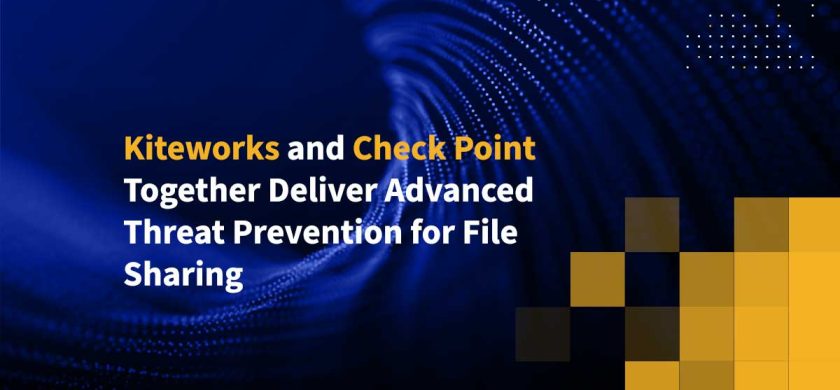
Kiteworks and Check Point Together Deliver Advanced Threat Prevention for File Sharing
Advanced threat prevention for file sharing is a necessity for any SMB or enterprise that hopes to defend against data breaches and cyber attacks.
Kiteworks and Check Point have partnered to make Check Point’s award-winning advanced threat prevention solution available for the Kiteworks secure file sharing and governance platform.
Why Enterprises Need Advanced Threat Prevention for File Sharing
In cyber defense, it’s becoming increasingly difficult to recognize and repel attacks. CISOs and security analysts might know who the attackers are—criminal syndicates, hackers, nation states, or other malefactors. But knowing exactly how the enemy is going to attack and where the enemy is going to penetrate the firewall has become a high-stakes, maddening hunt.
Detecting known malware is relatively easy so attackers have become experts at disguising their attacks. Stealth attacks, particularly those that employ zero-day vulnerabilities that have yet to be discovered, can cause serious damage by causing a data breach or by disrupting operations with a DDoS attack, ransomware, or some other form of malfeasance. Because zero-day attacks are often unleashed when an email recipient clicks on a file attachment, advanced threat prevention for file sharing becomes absolutely critical.
Advanced Threat Prevention for File Sharing Delivered: The Kiteworks Platform and Check Point SandBlast
Kiteworks (formerly Accellion) and Check Point today announced a joint partnership to deliver advanced threat prevention for file sharing. This solution, comprising the Kiteworks secure file-sharing and governance platform and the Check Point SandBlast advanced threat protection platform, assures CISOs and their security teams that all files shared through the Kiteworks platform have been scanned for zero-day threats, advanced persistent threats, ransomware, and other types of malware.
Through an integration with the Kiteworks platform, SandBlast can now analyze all files uploaded to Kiteworks or to any Enterprise Content Management (ECM) platform being managed through a Kiteworks connector. In addition, SandBlast can automatically analyze all files sent through Kiteworks email links. Because all files shared through Kiteworks now receive in-depth scrutiny for malware from the industry-leading advanced threat protection solution, enterprises achieve advanced threat prevention for file sharing.
“We see our partnership with Check Point as a very important step in furthering the secure sharing of sensitive information outside of an organization’s firewall,” said Jonathan Yaron, Chief Executive Officer at Kiteworks. “By integrating with SandBlast, we strengthen our security offering, which is a cornerstone of our strategy. Together, we can ensure that any information that enters or leaves the organization is protected and in turn reduces the risk of a data breach.”
“Within this current threat environment, it’s imperative for organizations to have full confidence that the information coming into and going out has not been compromised in any way,” commented Nathan Shuchami, Vice President, Emerging Products at Check Point Software Technologies. “By integrating Kiteworks with SandBlast, Check Point’s advanced threat prevention platform, we provide our customers additional peace of mind that their largest and most sensitive files remain secure and free of any malware, even as they travel beyond enterprise borders.”
With advanced threat prevention for file sharing, Check Point customers use SandBlast to protect Office 365 email, enterprise networks, web browsers, and devices such as PCs, Macs, smartphones, and tablets.
Know—and Stop—Your Enemy
Security attacks occur around the clock in continuously evolving patterns and with ever more subtle techniques. With advanced threat prevention for file sharing, enterprises stop attacks and protect their sensitive information.
To learn more about how Kiteworks integrates with advanced threat prevention and other security solutions to prevent data breaches and repel cyber attacks, schedule a custom demo of Kiteworks today.
Frequently Asked Questions
Third-party risk management is a strategy that organizations implement to identify, assess, and mitigate risks associated with their interactions with third-party vendors, suppliers, or partners. These risks can range from data breaches and security threats to compliance issues and operational disruptions. The process typically involves conducting due diligence before engaging with a third party, continuously monitoring the third party’s activities and performance, and implementing controls to manage identified risks. The goal is to ensure that the third party’s actions or failures do not negatively impact the organization’s operations, reputation, or legal obligations.
Third-party risk management is crucial because it helps to identify, assess, and mitigate the risks associated with third-party relationships. This can include cybersecurity threats, compliance issues, operational risks, and reputational damage.
Policy controls are essential in third-party risk management as they establish clear expectations for third-party behavior, data handling, and security practices. They help mitigate the risk of security incidents by defining acceptable actions, and ensure third parties comply with relevant laws, regulations, and industry standards. Further, policy controls provide a foundation for monitoring third-party activities and enforcing compliance, allowing the organization to take appropriate action in case of policy violations. Thus, policy controls serve as a critical framework for managing third-party risks effectively.
Audit logs are integral to third-party risk management as they offer a comprehensive record of all third-party activities within your systems. They aid in identifying potential risks by highlighting unusual or suspicious activities, serve as a crucial resource during incident response and forensic investigations, and help ensure regulatory compliance by providing proof of effective security measures and third-party monitoring. In addition, they foster a culture of accountability and transparency among third parties, deterring malicious activities and encouraging adherence to security policies.
Kiteworks helps with third-party risk management by providing a secure platform for sharing and managing sensitive content. The platform is designed to control, track, and secure sensitive content that moves within, into, and out of an organization, significantly improving risk management. Kiteworks also provides two levels of email encryption, Enterprise and Email Protection Gateway (EPG), to secure sensitive email communications. This helps to protect against third-party risks associated with email communication.
Additional Resources
- Glossary Security Risk Management
- Glossary Some Important Supply Chain Risk Strategies
- Glossary Integrated Risk Management (GRC)
- Blog Post A Guide to Information Security Governance
- Glossary Why Cybersecurity Matters